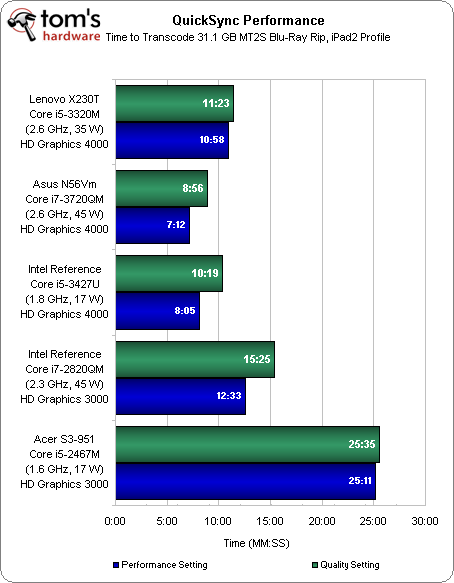Lenovo's ThinkPad X230T Tablet PC, Tested And Reviewed
Transcoding Performance, Accelerated By Quick Sync
Quick Sync remains one of the most useful and innovative features to come from Intel in recent memory. Using optimized software, the features comprising Quick Sync accelerate video decode and encode, making it possible to reformat content in a fraction of the time that would have been required by x86 cores operating on their own. Its utility on the X230T, however, is debatable.
Most folks maintain media libraries on large local or networked disk drives. They're far more likely to transcode video on a potent desktop and then move it over to a mobile device like the X230T. Of course, that might not be an option for a professional perpetually on the road. Quick Sync does make it possible to transcode video quickly (and with little power cost), and then move it over to a smartphone, for example. We've also used it at trade shows to get video YouTube-ready.
With the exception of Lenovo's X230T, all of the systems we benchmarked benefit from Crucial's m4 SSD. As a result, it's no surprise to see the X230T fall behind in our Quick Sync test. Its storage subsystem simply isn't fast enough to keep up, creating a bottleneck. However, upgrading to a SATA 6Gb/s-class SSD allows the X230T's Core i5-3320M to fall right between the beefier 45 W Core i7-3720QM and 17 W Core i5-3427U.
Get Tom's Hardware's best news and in-depth reviews, straight to your inbox.
Current page: Transcoding Performance, Accelerated By Quick Sync
Prev Page PCMark 7 Results: Comparing Other Tablet PCs Next Page Can The ThinkPad X230T Game?-
greghome The problem I see with the X-T series Convertible tablets though, is that for the same price I can purchase a X230 and a Thinkpad Tablet and still have money left.Reply
I can imagine a market for it, but once the Thinkpad Tablet 2 launches with Windows 8, I'd say there market would grow even smaller. just my 2 cents :) -
ojas Hmmm interesting to see the A5 just about manage to keep up with the two year old Atom N450.Reply
Anyway, Tom's: X1 Carbon review please! :D
Read that its trackpad is best-in-class for a Windows laptop. -
Zetto These machines should come with the leather sleeve included, it really comes into it's own in the sleeve.Reply
I've carried an older model around all day for years, the battery lasts 8 hrs easy with a good power profile setup and intermittent use.
OneNote is gold on it.
My users often borrow it just for it's presentation benefits as well.
This new model will shine with Win 8. -
jaquith As a past owner of the IBM/Lenovo Convertible I very rarely used it as a 'Tablet.' However, with Windows 8, and I don't like Windows 8, you'd probably use the 'Tablet' mode a lot more.Reply
I use an HP EliteBook Mobile Workstation and have little desire to go back to the Tablets.
Originally I wanted folks to be able to 'sign contracts' out in the field, but in practice Paper wins. -
cknobman Lets see:Reply
Big, thick, heavy
Ugly
Crappy battery life
When you think about it I could:
Buy an Asus Zenbook 1080p for $999
Google Nexus tablet for $199
Both combined would be as thin and light (or thinner/lighter) than this lenovo contraption while offering superior battery life and screen quality (at least on the ultrabook).
This product just seems like a fail. -
cknobman - you're really not the target market for this thing. They're fantastic for health care, home health, etc.Reply
-
greghome cknobmanLets see:Big, thick, heavyUglyCrappy battery lifeWhen you think about it I could:Buy an Asus Zenbook 1080p for $999Google Nexus tablet for $199Both combined would be as thin and light (or thinner/lighter) than this lenovo contraption while offering superior battery life and screen quality (at least on the ultrabook).This product just seems like a fail.Reply
From your post, I'd say you've never really used a IBM Thinkpad before.
The Thinkpad lines were never meant for normal consumers like you. If you've compared to built quality as well, the Thinkpads, especially the T and W series are wonders.
and unlike the ZenBooks or Macbooks......you can step on them and the hinge will be able to stand it. -
cknobman greghomeFrom your post, I'd say you've never really used a IBM Thinkpad before.The Thinkpad lines were never meant for normal consumers like you. If you've compared to built quality as well, the Thinkpads, especially the T and W series are wonders.and unlike the ZenBooks or Macbooks......you can step on them and the hinge will be able to stand it.Reply
Actually I've used ThinkPads a lot as I am a software developer. Two of my last 4 jobs issued them to the developers as their primary workstations. ThinkPad build quality, usability, design are all top notch for business users.
My comment was in response to the way this article was phrased. This article was not necessarily written in the context of a business user and actually was slanted more towards personal use and its ability to replace a tablet and laptop combo while traveling.
In that context I do see this product as a fail. -
Wisecracker I thought it was common knowledge that Acer and Compal have Trinity Win* Tab-hybrids coming out next month -- may even be articles on Toms about it.Reply
I can't really recall but pricing was something "less than $900" with Brazos II models substantially less.

